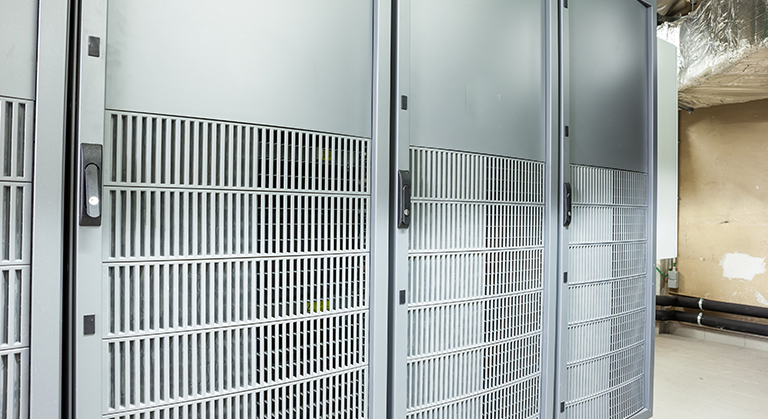One of the most crucial parts of any critical power infrastructure in a business is the Uninterruptable Power Supply or the UPS. While the UPS as a whole is considered to be a backup power generator, it is actually the batteries of the device that keep the system and all its internal components running in the event of a power cut or electrical failure. Despite the important role that they play, it is the UPS batteries that are neglected the most. However, before we delve into the subject of UPS battery types in detail, let us understand the concept, function, and importance of the Uninterruptable Power Supply (UPS) system in a business.

What is an Uninterruptable Power Supply?
A UPS is a device that provides backup battery power when the regular source of electrical energy is interrupted or if the voltage fluctuates frequently and significantly. Connecting the critical electrical equipment of a business organization to the UPS provides us with the necessary time required to shut down the device in a proper manner and to prevent internal damage.
Types of UPS Batteries and their Functions:
The one size fits all concept does not work when it comes to UPS battery types. As a matter of fact, for many years, the smaller uninterruptable power supplies only used Valve Regulated Lead Acid battery while the bigger double-conversion UPS systems depended on flooded-cell vented lead acid batteries to provide backup power. These batteries were also joined by a new member – lithium-ion batteries – some 20 years ago. Here are the different types of UPS batteries that are currently used for use in the UPS systems:
Valve Regulated Lead Acid Battery (VRLA):

If all the UPS battery types are compared, then it can be said with surety that the VRLA battery is the most common UPS battery type available in the market. These batteries are also known as maintenance-free or sealed lead acid batteries (SLA). Some of the most distinguishing features of VRLA batteries have been listed below:
1) VRLA batteries have lower upfront costs
2) VRLA batteries, compared to other types of UPS batteries, are relatively safe in the long-term
3) These batteries are easily available in the market
4) VRLA batteries require minimal upkeep and maintenance
The average lifespan of a VRLA battery ranges from three to seven years and will require regular testing and cleaning to keep the batteries functional till the end of its shelf life. The name valve regulated is derived from the way the gas is released from a VRLA battery. In case the pressure inside the battery increases significantly, the valve will help vent out the extra gas. This is essential for the smooth functioning of the battery, as a temperature above or below 77 degrees is considered harmful for the VRLA batteries. The optimal environment to keep a UPS with VRLA batteries is to store it in a place that is temperature-controlled and dry.
Given the fact that water cannot be added to VRLA batteries externally, it is important to keep the environment around the battery cool to prevent rapid water loss. An increased rate of evaporation can harm the battery and reduce the manufacturer-marked lifespan of the product.
Absorbent Glass Mat Batteries (AGM):
AGM UPS batteries are a sub-category of VRLA batteries, where the electrolyte is held together by woven glass fiber mats. This unique and flexible design helps enhance the self-discharge rate and stretches the range of operational temperature for the battery.
Gel Cell UPS Batteries:
Another subtype of a VRLA battery, the Gel Cell UPS batteries were originally created in the early 1930s to power portable electronic items. Gel batteries were preferred over other batteries as this battery subtype was less likely to sustain damage via rough handling. The modern gel cell uses a concoction made of sulfuric acid and pyrogenic silica and is famed for its high tolerance of vibration.
Vented Lead Acid Battery (VLA):
Vented lead acid battery, commonly known as the wet cell or flooded battery, is not only an exceptionally reliable UPS battery type, but also comes with a lifespan of two decades. VLA batteries consist of thick plates made of lead, their interiors flooded with electrolyte acid. Compared to the VRLA UPS batteries, the VLA batteries have higher upfront costs.
VLA batteries require regular upkeep and careful handling for effective performance. Wet cell UPS batteries must be stored in places with proper ventilation, and they must not be moved too much as this can lead the corrosive electrolyte acid to spill out.
Lithium-ion Batteries:
Over the years, the design of the lithium-ion batteries has changed significantly. Today, lithium-ion batteries are used not only for UPS but also to power electric vehicles. These UPS batteries are light-weight and small and come with built-in battery monitoring and management systems. The in-built battery management system keeps a check on the voltage, charge current, cell voltage balance, and the temperature of the batteries.
For example, if the temperature of the battery increases significantly, the monitoring system adjusts the ambient temperature by disconnecting strings and single battery connections to cool down the device. In case the situation still persists, the inbuilt battery management system can sound alarms for external intervention.
In Conclusion:
Now that you know the advantages of the different types of UPS batteries, be sure to choose the one the fulfills your requirements the best. Before you choose a UPS battery, it is important to understand what options you have and if you are capable of managing and maintaining them properly for the best results.

